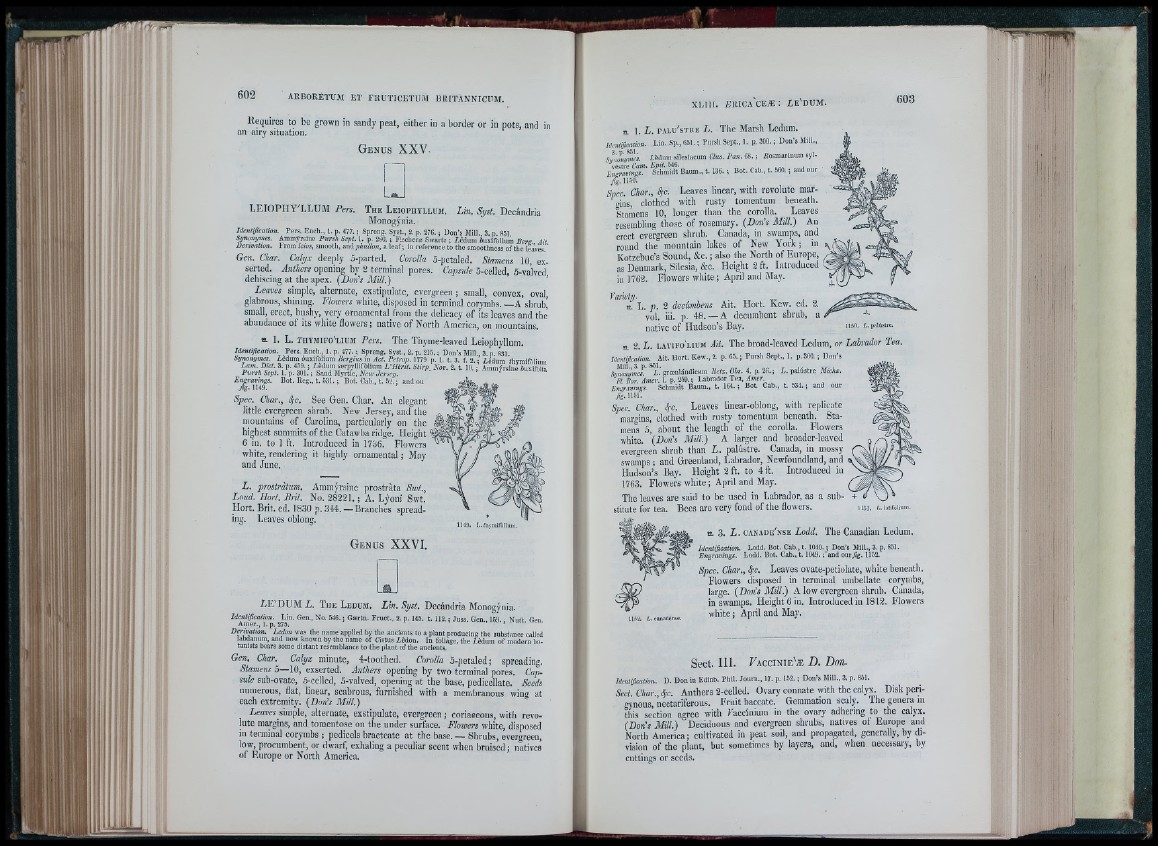
I I;
lleqiffrcs to be grown in sandy peat, either in a border or in pots, and in
an airy situation.
G e n u s XXVSyst.,
LEIOPHYT«LUM Pers. The L e iophyllum . Lin. Syst. Decándria
Monogynia.
Identification. Pers. Ench., 1. p. 477. ; Sj
2. p. 276. ; Don’s Mill., 3. p. 851.
Synonymes. Ammÿrsine Pursh Sept. 1. ]
; Fischerà Swartz ; Xèdum éuxifòlium Berg., Ait
Derivation. From leios, smooth, and p/m,
•; a leaf ; in reference to the smoothness of th e leaves.
Gen. Char. Calyx deeply S-parted. Corolla S-petaled. Stmnem 10, exserted.
Anthers opening by 2 terminal pores. Capsule S-celled, S-valved
dehiscing at the apex. (Doris M ill) ’
Leaves simple, alternate, exstipulate, evergreen ; small, convex, oval,
glabrous, shining. Flowers white, disposed in terminal corymbs. —A shrub’
small, erect, bushy, very ornamental from the delicacy of its leaves and tin!
abundance of its white flowers; native of North America, on mountains.
n- I. L. th ym ifo 'lium Pers. The Thyme-leaved Leiophylli
V Jersey.
fig 1149“ )t. Reg., t. 531. ; Bot. Cab., t. 52.; and ou
Spec. Char., S/i- See Gen. Char. An elegant
little evergreen siirub. New Jersey, and the
niountains of Carolina, particularly on the
highest summits of the Catawba ridge. Height
6 in. to ] ft. Introduced in 1736. Flowers
white, rendering it highly ornamental ; May
and June.
um.
831.
lum ihymlfTiliiim
Ammÿrsine iuxifòlia
L. prosb'dkm. Ammyrsine prostrata Swt.,
Loud. Hort. Brit. No. 28221. ; A. Lyoiu' Swt.
Hort. Brit. ed. 1830 p. 344. — Branches spreading,
Leaves oblong.
G e n u s X X VI.
1149. L. fhyinifòliuii
L E 'DUM Zî. The Ledum. lAn. Sy.st. Decándria Monogynia.
Identification. Lin. Gen., No. 546.; Gærtn. Fruct., 2. p. 145. t. 112. ; Juss. Gen.. 1-59. • Nutt Gen
Amer., 1. p. 275.
Derivation. Ledon was the name applied by the ancients to a plant producing the substance called
labdanum, and now known by the name of Cistus iè d o n . In foliage, the iè d um of modern botanists
bears some distant resemblance to the plant o fth e ancients.
Gen. Char.^ Calyx minute, 4-toothed. Corolla S-petaled; spreading.
Stamens S—10, exserted. Anihers opening by two terminal pores. Cop-
sule sub-ovate, S-celled, S-valved, opening at the base, pedicellate. Seeds
numerous, flat, linear, scabrous, furnished with a membranous wing at
each extremity. (Doris Milt.)
I,<?OTra simple, alternate, exstipulate, evergreen ; coriaeeous, with revolute
margins, and tomentose on the under surface. Flowers white, disposed
in terminal corymbs ; pedicels bracteate at the base. — Shrubs, evergreen,
low, procumbent, or dwarf, exhaling a peculiar scent when bruised ; natives
of Europe or North America.
a. 1. L. P.VLU'STKE L. The Marsh Ledum.
Idmtlfldatiim. Lin. Sp., 051. i Puvsh Sept., 1. p. 300. ; Don's Mill.,
s£m /m * s . f.èdum sileslacura Clus. Pan. 66. ; fiosmarliium sylh
ï S n v t n f k sS h fltoB aum ., t. 136. ; Bot. Cab., t. .560. ; and mir
* .U 5 0 .
Spec. Char., f r . Leaves linear, with revolnte margins,
clothed with rusty tomentum beneath.
Stamens 10, longer than the corolla. Leaves
resembling those of rosemary. (Doris M ill) An
erect evergreen shmb. Canada, in swamps, and
round the mountain lakes of New York ; in
Kotzebue’s Sound, &c. ; also the North of Europe,
as Denmark, Silesia, &c. Height 2 ft. Introduced
iu 1762. Flowers white ; April and May.
Variety.
n- h, p. 2 decimthens Ait. Hort. Kew. ed. 2,
vol. iii. p. 48. — A decumbent shmb, a
native of Hudson’s Bay.
B- 2. i . LATIFO LIUM Alt. The broad-leaved Ledum, or Labrador Tea.
Mi-nlification. Alt. Hort. Kew., 2. p. 65. ; Pursh Sept., 1. p. 300. 1 Don’s
Sï™ ? • ' grccnländicnm Itetz. Obs. 4. p. 26. ; L . palüslre Micha.
PI. ¿er. A»»«-. 1. p. 259.1 Labrador Tea, dinei-
En"r:ivings. Schmidt Banm., t. 104. ; Bot. Cab., t. 534. ; and our
* . 1151.
Spec. Char., SfC. Leaves linear-oblong, with replicate
margms, clothed with rusty tomentum beneath. Stamens
5, about the length of the corolla. Flowers
white. (Doris Mill.) A larger and broader-leaved
evergreen shrub than L . palustre. Canada, in mossy
swamps ; and Greenland, Labrador, Newfoundland, and
Hudson’s Bay. Height 2 ft. to 4 ft. Introduced in
1763. Flowers white ; April and May.
The leaves are said to be used in Labrador, as a substitute
for tea. Bees are very fond of the flowers.
1150. ft. palústre.
1152. canadénse.
11. 3. L . c a n a d e 'n s e Lodd. The Canadian Ledum.
Identification. Lodd. Bot. Cab., t. 1040.; Don’s Mill., 3. p. 851.
Engravings. Lodd. Bot. Cab., t. 1049. ;'and Quvfig. 1152.
Spec. Char., Leaves ovate-petiolate, white beneath.
Flowers disposed in terminal umbellate corymbs,
large. {Doibs Mill.) A low evergreen shrub. Canada,
in swamps. Height 6 in. Introduced in 1812. Flowers
white; April and May.
Sect. III. Taccinie'^ X). Don.
Identification. D. Don in Edinb. Phil. Journ.. 17. p. 152.; Don’s Mill., 3. p. 851.
Sect Char 4c. Anthers 2-celled. Ovary connate with the calyx. Disk perigynous,
nectariferous. Fruit baccate. Gemmation scaly. The genera in
this section agree with Faccinium in the ovary adhering to the calyx.
(Don’s Mill.) Deciduous and evergreen shrubs, natives of Europe and
North America; cultivated in peat soil, and propagated, generally, by division
of the plant, but sometimes by layers, and, when necessary, by
cuttings or seeds.
í L i '